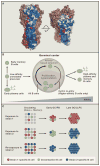Germinal center selection and the antibody response to influenza
- PMID: 26496601
- PMCID: PMC4623701
- DOI: 10.1016/j.cell.2015.10.004
Germinal center selection and the antibody response to influenza
Abstract
In this Minireview, we discuss basic aspects of germinal center biology in the context of immunity to influenza infection and speculate on how the simultaneous evolutionary races of virus and antibody may impact our efforts to design a universal influenza vaccine.
Copyright © 2015 Elsevier Inc. All rights reserved.
Figures

References
Publication types
MeSH terms
Substances
Grants and funding
- 1P01AI097092/AI/NIAID NIH HHS/United States
- HHSN272201400005C/PHS HHS/United States
- U19 AI057266/AI/NIAID NIH HHS/United States
- DP5 OD012146/OD/NIH HHS/United States
- 5DP5OD012146/OD/NIH HHS/United States
- 1P01AI097092-03/AI/NIAID NIH HHS/United States
- U19AI109946/AI/NIAID NIH HHS/United States
- U19 AI109946/AI/NIAID NIH HHS/United States
- 2U19AI057266-11/AI/NIAID NIH HHS/United States
- HHSN272201400005C/AI/NIAID NIH HHS/United States
- P01 AI097092/AI/NIAID NIH HHS/United States
- U19 AI082724/AI/NIAID NIH HHS/United States
LinkOut - more resources
Full Text Sources
Other Literature Sources
Medical

